Positive Health Online
Your Country

Extraordinary Healing Art that is Thai Massage
listed in thai yoga massage and bodywork, originally published in issue 212 - February 2014
These days, one of the most popular - but often misunderstood healing modalities - is traditional Thai massage.
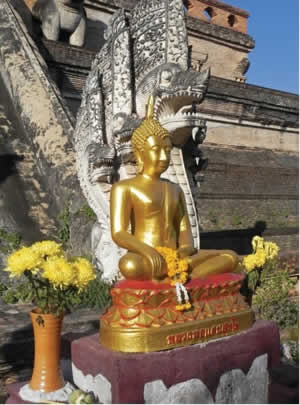
Buddha altar in front of Wat Chedi Luang, Chiang Mai, Thailand.
Photo by Bob Haddad.
So what is Thai massage? Well, for one thing, it’s not ‘massage’ as we know it in the West. In fact, it is unfortunate that the term ‘Thai massage’ has become so popular because that second word, massage, is misleading and inaccurate. Massage tables or oils and lotions aren’t used, there is no rubbing on the skin or kneading of the muscles, and the receiver remains clothed. The goal is not to work muscles, fascia, tendons, ligaments, organs, and soft tissue, though these anatomical elements are positively affected by the work. Neither is its purpose to simply stretch and apply passive yoga to another person on a floor mat. At its essence, nuad boran, as it is called in Thai language, is a balanced blend of physical, energetic, and spiritual healing techniques and concepts. It is the skilful combination of applying both broad and targeted acupressure, finding and dissolving blockages, stimulating energy lines (sen), opening and toning the body with yoga-like stretches, and last but not least, allowing and encouraging the receiver to engage in a process of self healing, deep relaxation, and renewal.
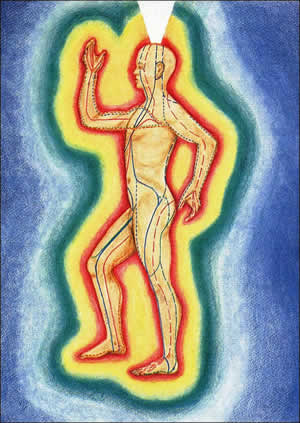
Side View of the sen sip in traditional Thai Massage.
Photo courtesy of the estate of Asokananada and Editions Duang Kamol.
About the Modality
Thai massage, at its essence, is a spiritual healing art, not just a physical therapy. In Thailand, massage (nuad) belongs to one of the branches of Thai medicine, and it incorporates Buddhist healing principles. Accomplished therapists and teachers understand the power of meditation and stillness while at work, both for the giver and the receiver. They work slowly and in a meditative way, and they always encourage silence.
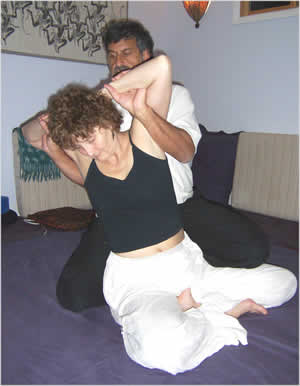
Spinal twist in seated position. Photo courtesy Bob Haddad
Good body mechanics and correct breathing play extremely important roles in Thai massage. An experienced Thai therapist works only within his immediate reach, and positions his body directly alongside or above the area where he is working. The hara, the core area located slightly below the navel, is where all movement should originate. A therapist’s back should be straight, the shoulders relaxed, the chest open, and in most cases, arms should be straight and locked at the elbows when applying pressure. Masterful Thai therapists utilize correct breathing patterns as they work, they remain observant of their client’s breathing throughout each session, and they adjust their breathing to work most effectively with that of their client.
Thai massage is most powerful and effective when it is carried out, for the most part, in silence. The therapist needs to focus his energies, observing and listening to the body, hearing the breath, and adapting his techniques to the needs of the individual before him. The receiver should ideally feel at peace, relaxed, spiritually centered, and in a parasympathetic state, since these conditions always encourage good results.
Traditional Thai massage has roots which extend back to Indian Ayurvedic medicine and ancient Buddhist medicine, and it evolved in Thailand where stillness and softness are important cultural and spiritual norms.
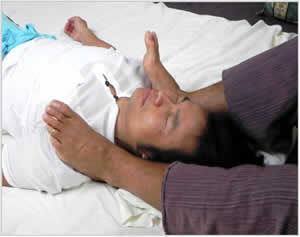
Shoulder compression using feet. Photo courtesy Bob Haddad.
Individualized Treatments
Traditional Thai massage isn’t a sequence of techniques and movements that can be applied to all people. Teachers and schools that train students to follow proprietary fixed sequences for all clients may be hindering students from growing into deeply sensitive therapists. Along the way, there must be adaptation, exploration, and experience with a wide variety of different people. Generally speaking, only after several years of practice and study can one develop the sensitivity and awareness that is needed to effectively work with each person in an individualized fashion.
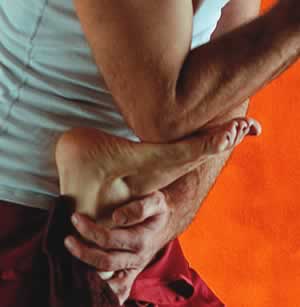
Foot acupressure using elbow.
Photo courtesy Danko Lara Radic
Individualized holistic treatment is at the heart of Thai healing arts, and Thai massage should be administered in this way in order to be fully effective. An accomplished Thai therapist continually practises and studies, preferably with a variety of teachers, throughout his entire career. He ‘listens’ to the body of each client as he works, learns to sense energy flow and blockages, and relies on intuition, sensitivity, and stillness to guide him through each treatment.
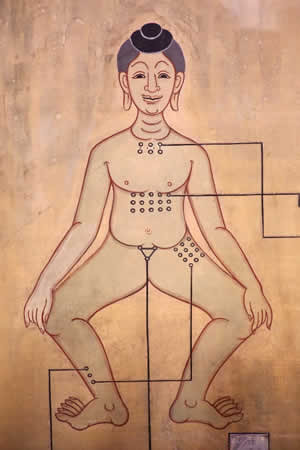
Epigraph of anterior energy points, Wat Po, Bangkok.
Photo courtesy Bob Haddad.
Finding Qualified Therapists and Teachers
Unfortunately, the world is filled with people who teach or practice Thai massage without having adequate knowledge or study experience. Some new practitioners may study only for a few weeks or months before beginning to charge money for their services. All too often, students who take a hurried approach to learning emerge as unaccomplished and unrefined practitioners.
The fact that Thai massage inherited passive yoga stretches from the India confuses some students and therapists into believing that Thai massage sessions should be based entirely on assisted yoga techniques, though this is hardly the case. If your Thai massage therapist simply stretches and compresses you into yoga positions, you are not receiving traditional Thai massage. Mixing Thai massage with other established modalities such as western table massage and yoga is also common. These hybrid forms may include elements of nuad boran, but they shouldn’t be confused with, or presented as traditional Thai massage.
For all these reasons, it’s important for students of Thai massage to pursue study only with highly qualified teachers. It’s also important for consumers to thoroughly investigate a prospective therapist before making an appointment for a Thai massage. Whether searching for a teacher or a therapist, check the person’s study and training history. If it’s not listed on their web site or in their promotional information, ask them. How long have they studied Thai massage, and with whom? Have they studied in Thailand? If so, when was the last time they were there? Do the descriptions of their services use western anatomical language or Eastern healing terminology? Do they blend Thai massage with other modalities? Are they members of Thai Healing Alliance, or do they at least meet the minimum requirements for Registered Thai Therapist (200 hours) or teacher (500 hours)? Before you make an appointment for a Thai massage or register for a course in Thai massage, check into each person’s background just as you would for a prospective employee, or a tenant for your rental home. To learn more about suggested world standards for the practice and study of traditional Thai massage, or to find a qualified therapist or teacher in your area, visit the Thai Healing Alliance web site at www.thaihealingalliance.com.
Summary
Traditional Thai massage is a unique and powerful vehicle of healing, and it is worthy of being practiced, taught, and promoted within the context of traditional Thai medicine, not from a perspective of Western bodywork therapies, Ayurvedic medicine, Chinese medicine, or any other body of knowledge. Thai massage has been treating and helping people to improve their physical and spiritual health for a very long time. There is every indication to believe it will continue on this path well into the future.
Comments:
-
No Article Comments available